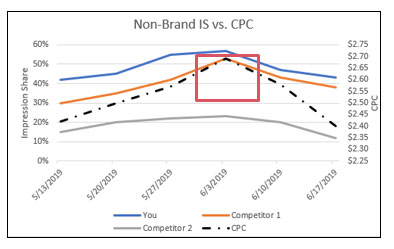How to Optimize for Seasonality in Paid Search Campaigns

Understanding when seasonality will affect your paid search campaigns is crucial to planning and executing tactics at these times. But that can be difficult for accounts with no historical data. Here’s how you can prepare for seasonality when starting from scratch.
Gather Data From Multiple Sources
Ask the client if they’re aware of any seasonality trends. Using that information, we can dive into Google Trends, a simple tool that analyzes search queries based on date, region, and language. Pull a few branded and non-branded terms that you’re bidding on in your current campaigns. Are there any noticeable peaks or drops?
Location3’s partnerships with Google and Microsoft are essential to the next part of the process. Through these partnerships, we’re able to analyze industry benchmarks on client competitors. This allows us to break down vertical performance by device, demographics, and time of year — ensuring we don’t miss out on any opportunity.
Where Does the Data Match?
Now that we’re equipped with information from the client and their competition, we can start cross-referencing the dates they’ve identified, Google Trends data, and the industry benchmarks. If you’re seeing common peaks in this analysis, you can conclude that seasonality is likely a major factor in performance.
Let’s take a look at an example:

The graph above was taken from Google Trends. You’ll notice that searches for this particular term peak in November, December, and May. November and December also were identified by the client as a high-volume period due to the holiday season. That’s easy enough. But the real insight here is the peak in May.
Put the Puzzle Pieces Together
While at first the month of May might seem random, the client told us that they see high foot traffic in stores before Mother’s Day, annually held on the second Sunday of May. It’s also a time of the year when the client’s products, a common outdoor yard ornament, are most relevant. This gives us a strong hint that seasonality is driving consumer behavior.
Tactics to Adjust Based on Seasonality
From this conclusion, we can start preparing our paid search campaigns for peak seasonality. The first way we can optimize for seasonality is tailoring ad copy to the motivations that were identified through Google Trends and client intel.
In this example, we could test “Get Your Yards Ready” and “Perfect Gifts for Mom”. The volume of searches during this peak period will give us quicker results than off-periods, allowing us to fine-tune ad copy in existing campaigns as well as apply our insights to future campaigns.
The next way we can adjust for seasonality is through Smart Bidding. New settings in the Google Ads feature use machine learning to adjust bids based on your desired date range, device breakout, and the expected spike in conversion rate.
Add Context to Your Campaign Strategy
Once you begin to gather data, be sure to monitor competition impression share using the auction insights report in Google Ads. Below, we charted cost-per-click (CPC) along with top competitors to see the correlation between increased competitive pressure and the amount we pay.

This shows how we’re able to successfully navigate the auction space during peak periods — increasing bids at the optimal time to maintain an advantage in impression share over the competition.
Conclusion
Capturing quality conversions in high-volume periods is an essential strategy for all paid search campaigns, and even the best strategies only work when met with proper planning. You can prepare for seasonality by:
- Working with your client to identify their peak seasons
- Digging into the available data via Google Trends and any professional partnerships
- Analyzing the data to support campaign tactics, including ad copy variations, seasonality adjustments for Smart Bidding, and landing page experience
- Apply insights from current campaigns to future seasonal campaigns, including budget planning for campaigns during all seasons
If there’s anything else to be learned from this post: Don’t wait until the last second to buy a Mother’s Day gift. 😊
Stay In Touch.
Subscribe to our monthly email newsletter.
